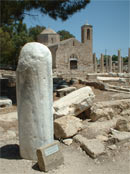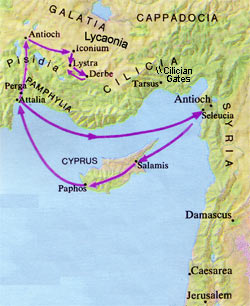Journeys with an Apostle – First Mission Paul in Cyprus and Galatia
Real or Imagined?
Did Saint Paul, native of Tarsus and Roman citizen as he claimed, really make the journeys ascribed to him – or are they just a frame upon which to hang his seminal epistles? Did this erstwhile Rabbi Saul, student of Gamaliel and Pharisaic Jew, really sally forth over sea and mountain – or could the story of his travels have been concocted precisely to framework missives of orthodoxy aimed at recalcitrant synagogues of the Jewish diaspora? A century of archaeology appears to confirm a few circumstantial details mentioned in his letters and yet the biblical account gives one cause to wonder.
On the Island of Love
After a stopover at Salamis the apostles “go through” the island (the cities of Citium, Amathus and Curium don’t get a mention) and make straight for the Governor in Paphos, who conveniently has sent word that he wants to hear them. (Why, one wonders? Did they cause such a commotion at the other end of the island? And if so why do we not know of it?) All it takes is the spiteful blinding of a rival magician (curiously named “Bar Jesus”) and Sergius Paulus, Roman aristocrat and doubtless the richest, as well as the most powerful, man on the island, is enrolled among the ranks of the Christians. “By tradition” Cyprus becomes the first country governed by a Christian, though oddly we never hear of Sergius again, and nor is there any evidence of early Christianity on the island. Hereafter, Rabbi Saul is known by his latin name Paulus (which just happens to be the name of the Governor).
One good yarn deserves another


Reality Check

Aerial view of the proconsul’s residence, Paphos.
Did Paul make it past the front door?
Where did they get their ideas from?
Where did they get their ideas from?


Theological Agenda
Postscript: Fraudulent in tooth and claw
Holiness that has no limits
Sources:
- Hermann Detering, The Falsified Paul, Early Christianity in the Twilight (Journal of Higher Criticism, 2003)
- A. N. Wilson, Paul, The Mind of the Apostle (Sinclair-Stevenson, 1997)
- John Ziesler, Pauline Christianity (Oxford, 1990)
- Edward Stourton, In the Footsteps of Saint Paul (Hodder & Stoughton, 2004)
- John Drane, Introducing the New Testament (Lion, 1999)
- J. Murphy-O’Connor, Paul, A Critical Life (Clarendon, 1996)
- J. Murphy-O’Connor, Paul, His Story (Oxford, 2005)
St Paul – Real or Imagined?
- A Jew called Saul? An apostle called Paul? A witness to Jesus? Or plain invention?
Two Different Pauls in Epistles and Acts, plus an Extra, Saul - Big city tour? Athens, Corinth, Ephesus?
Magical Mystery Tours – A Greek Odyssey - Voyage to Rome? A martyr’s death? “Tradition” versus truth.
Magical Mystery Tours – The Road to Rome - Epistles? Letters home? Papering over the cracks.
From our own Correspondent Part 1 Part 2

The curious route of St Paul's first mission
Aphrodite – the original beauty



Pagan tastes of the Proconsuls at Paphos



Paul was here?
Jew free?

Paul was here?

"Death for Naked Racing"

Ancient tomb given a Christian makeover

